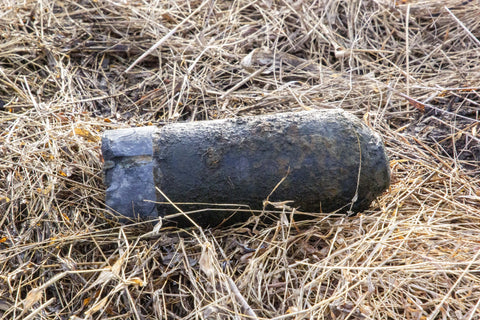
Rare Unexploded Artillery Shell Discovered at Gettysburg. Yes, Really.
The pockmarked and battle-scarred landscapes of the Somme, Verdun, the Marne still give up shells, bullets and ordnances. Unexploded Second World War bombs are still unearthed from European fields.
Such potential killers, however, are not likely found on the plains and in the forests of the United States. That is, until this week. On Thursday, a spokesman for the Gettysburg National Military Park reported that an unexploded ordnance shell was found near Little Round Top — the sight of some of the fiercest fighting during the Battle of Gettysburg.
According to The Washington Post, it is believed to be a Confederate shell that had been fired upon Union soldiers, the bullet-shaped shell, which appeared to be a 3-inch diameter, 10-pound Dyer shell, was found by archaeologist Steve Brann, conducting a preliminary ground sweep with a metal detector. The area around Little Round Top has been undergoing an 18-month rehabilitation project that began this past July.
Using a pinpoint detector and shovel, Brann began to work the ground. He was used to finding Minié balls, percussion caps from firearms and the like. But this reading was stronger. And much farther down.
“He was starting to get frustrated because he kept getting hits but he still wasn’t finding anything,” Jason Martz, spokesman for Gettysburg National Military Park, told The Post.
After 20 inches, Brann figured he discovered a fragment of an artillery shell. He was not expecting an unexploded round.
Only five such shells have been found at the famed battlefield since 1980.
“He laid it gently on the ground, took a picture of it and ran for the hills,” Martz told CNN.
According to Martz, the shell could have been fired from a gun called a three- inch ordnance rifle, or from a 10-pound Parrott gun. The shell could have been solid, or it could have contained an explosive charge, which is why the park took immediate precautions.
Park officials were notified and the 55th Ordnance Disposal Company EOD team from nearby Fort Belvoir, Virginia “safely removed the shell before it was destroyed off-site,” according to the park’s Facebook page.
“I heard it from my office,” Martz told The Post. For safety, none of it was saved for display.
Little Round Top [h2]
The park’s assumption is that the shell was fired by the Confederates on July 2, 1863, the second day of the battle, as Union and Confederate forces fought for dominion over Little Round Top and the rocky landscape of Devil’s Den.
On that day, it was the 20th Maine’s epic stand and bayonet charge at Little Round Top that secured that regiment’s place in military history.
“During the second day of fighting at Gettysburg, commanders Colonel Joshua Chamberlain and Major Ellis Spear — already good friends from before the war — further forged a seemingly unbreakable bond in helping the Pine Tree State boys turn back Colonel William Oates’ relentless 15th Alabama and prevent a Confederate breakthrough on the Army of the Potomac’s left flank. Had the 20th Maine broken before the onslaught, it might have had a domino effect on other hard-pressed Federal units along Cemetery Ridge. The 20th’s stand was a critical moment in what became a Yankee triumph the following day,” writes Tom Desjardin.
The possible Confederate ordnance is just one other reminder of the ghastly consequences of that bloody day, and the violence that saved the Union.
“There are likely still bodies on the battlefield,” Martz told the Post.
“We treat this battlefield as a cemetery.”
historynet magazines
Our 9 best-selling history titles feature in-depth storytelling and iconic imagery to engage and inform on the people, the wars, and the events that shaped America and the world.
